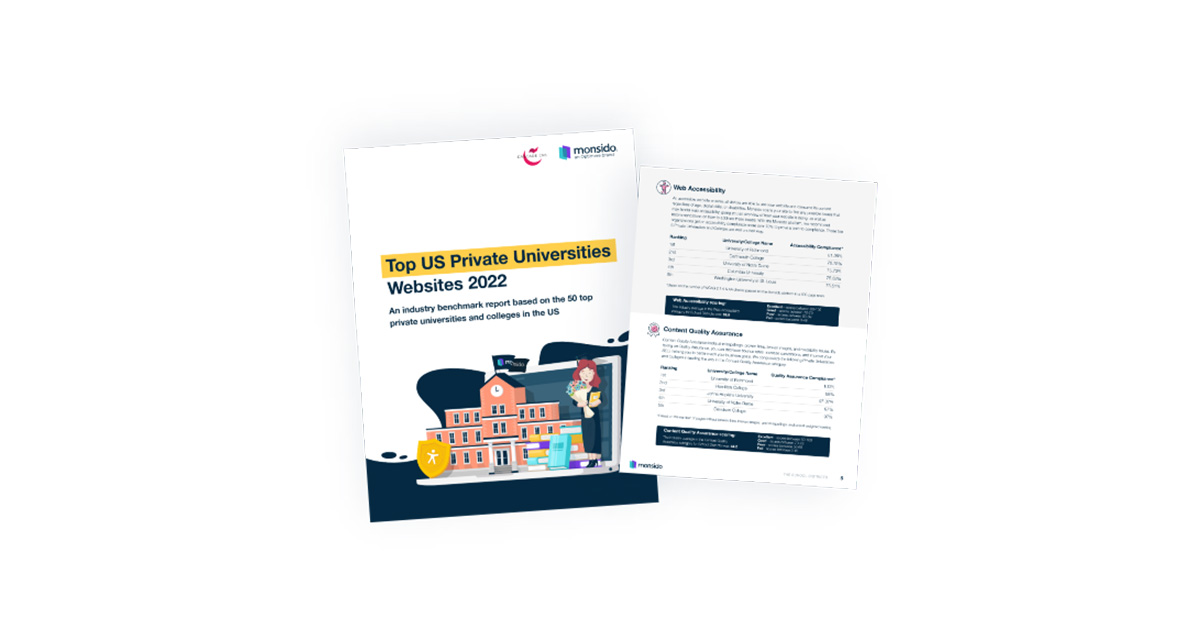NOTE: As part of our sponsor agreements with Annual Conference sponsors, we occasionally post information provided by our sponsor-partners on their behalf. This is one such article.
Higher education websites are a vital part of the student recruitment process, as well as a vital information hub for enrolled students, alumni and staff. Yet as a so-called “living” and evolving digital asset, there may be aspects of your higher education website that are not always fully optimized, inclusive or accessible for all your prospective website visitors.
The role of university or college websites
The website is far from the only communication platform used in the higher education space. From school email systems to intranets to learning portals, there are many different forms of digital communication that are vital to the higher education community. However, the higher education website does play a few important roles in this exchange, including:
- Prospective students: Not all students have the financial means to visit a higher education institution before applying or enrolling. In these cases, the website plays an important role in giving prospective students the information they need to make a decision about applying to the school. The school website replaces school tours, talking to enrolled students, meeting with financial aid counselors, visiting on-site accommodations and dorms, and more.
- Parents and guardians: For parents and guardians, the college or university website is yet again an important source of security and information with regards to enrolling their child at your institution. In addition, parents and guardians are most likely the financial benefactors, and winning their trust can play an important role in the enrollment process.
- Enrolled students: For enrolled students, the higher education website is central to daily university activities, descriptions of classes, engagement with professors and students, and more. Beyond educational information, the school website is also vital for disseminating information such as school policies, news and events, housing and meal updates, and more.
- Alumni: The website is the natural point of engagement for many alumni, looking to see what updates have been made and/or any news. In addition, alumni sections can play an important role in encouraging alumni connections, gatherings and donations.
- Staff: And lastly, the website is not only an external information hub – but likewise an important source of information for staff. Whether it be campus updates, departmental news or school events, the website is the official information source for all larger happenings, including for staff.
Our 2022 website benchmark
At the start of 2022, Monsido, along with Hannon Hill – the makers of Cascade CMS – decided to take a look at a sample of websites from the higher education industry to see how their websites were performing across different website elements and aspects. The report looks at how university and college websites are performing, what areas they are successful with, and where they need to improve. The report was based on the websites of 50 private universities to give an indication of the health of the industries’ websites.
Tested categories and industry benchmarks
The categories that were tested in this website benchmark for private universities included some of the most common website performance aspects and elements. This includes web accessibility, content quality assurance, response time, SEO, performance and uptime. The industry benchmark for each of these categories was:
- Web accessibility: 71.5, which falls within the “good” range
- Content quality assurance: 59, which falls within the “poor” range
- SEO: 83.8, which falls within the “good” range
- Performance: 57.2, which falls within the “poor” range
- Response time: 684ms, which falls within the “fail” range
- Uptime: 99.9%, which falls within the “pass” range
For more on the top performers in each of these individual categories, download the full report.
The top performing websites
The website benchmark report looked at both top performing websites overall, as well as in individual categories. The top performing websites for private universities in the higher education space in 2022 were:
- 1st: The University of Notre Dame
- 2nd: Harvard University
- 3rd: University of Richmond
- 4th: Washington University in St. Louis
- 5th: University of Pennsylvania
This overall ranking is based on the average weighted ranking across all categories.
Find out more about what’s working, and what’s not
In addition to the quantitative data of the website benchmark, qualitative research was also fielded in the form of a survey of higher education professionals. The survey asked higher education professionals about:
- The size (number of pages) of their website
- The number of content contributors working on their website
- Their website goals, and if they were being achieved
- Their website challenges, and key performance indicators
For full insights, download a copy of the 2022 Top Private University Website Benchmark report. Learn more on the Monsido website, or by dropping by our virtual or in-person booth during the HighEdWeb 2022 Annual Conference!

